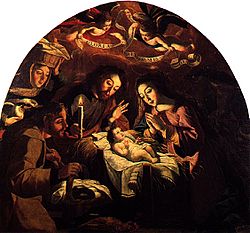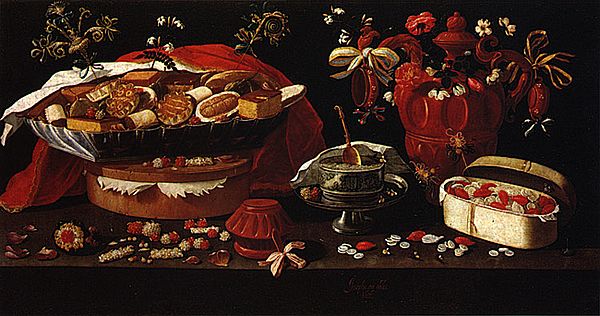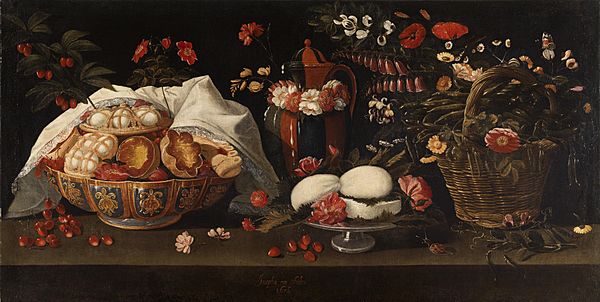Josefa de Óbidos facts for kids
Quick facts for kids
Josefa de Óbidos
|
|
|---|---|

Nativity of Jesus by Josefa de Óbidos, 1669, National Museum of Ancient Art, Lisbon
|
|
| Born |
Josefa de Ayala Figueira
c. 1630 |
| Died | 22 July 1684 (aged 54) Óbidos, Kingdom of Portugal
|
Josefa de Óbidos (born around 1630 – died July 22, 1684) was a famous Portuguese painter. She was born in Spain. Her real name was Josefa de Ayala Figueira. However, she often signed her paintings as "Josefa em Óbidos" or "Josefa de Ayalla".
Josefa lived in Portugal from the age of four. This was her father's home country. She created all of her artworks there. People believe she painted about 150 pieces. This makes her one of the most active Baroque artists in Portugal.
Josefa's Life Story
Josefa de Óbidos was born in Seville, Spain. She was baptized on February 20, 1630. A well-known painter, Francisco Herrera the Elder, was her godfather.
Her father, Baltazar Gomes Figueira, was a Portuguese painter. He came from the village of Óbidos. He went to Seville in the 1620s to learn more about painting. There, he married Catarina de Ayala y Cabrera. She was Josefa's mother. By May 3, 1634, Josefa's family was living in Óbidos. This was when her younger brother, Francisco, was baptized.
In 1644, Josefa stayed at the Augustinian Convent of Santa Ana in Coimbra. Her father was working nearby on a church altarpiece. While at the convent in 1646, Josefa made some engravings. These were of St. Catherine and St. Peter. They are her earliest known works with her signature.
Josefa's first signed painting is from 1647. It was a small painting called Mystical Marriage of St. Catherine. It was made for the Augustinian Monastery of Santa Cruz in Coimbra. In the same year, she painted other small works. One was a Nativity Scene with St. Francis and Saint Clare Adoring the Newborn Christ.
Sometime before 1653, Josefa and her family moved to Óbidos. There, she helped with a special book for the University of Coimbra. She painted an allegory (a symbolic picture) of Wisdom for the book's first page. Her father was also decorating the book.
Over the next few decades, Josefa painted many religious artworks. These were for churches and convents in central Portugal. She also painted portraits of people. And she created still-life paintings for private buyers.
Josefa wrote her will on June 13, 1684. In this document, she was described as being "emancipated" (meaning she was independent) and "a virgin who never married." She passed away on July 22, 1684, when she was 54 years old. Her mother and two nieces were still alive. Josefa was buried in the Church of Saint Peter of Óbidos.
Josefa's Artworks
During her career, Josefa de Óbidos received many important jobs. She painted altarpieces and other works for churches and monasteries. These were all over central Portugal.
For example, she painted six canvases for the Saint Catherine altarpiece. This was for the church of Santa Maria de Óbidos in 1661. She also painted six pictures of Saint Theresa of Ávila (1672–1673). These were for the Carmelite Convent of Cascais. Other works include an Adoration of the Shepherds (1669) and four paintings for the Casa de Misericórdia of Peniche (1679).
Many of her still-life paintings are very famous. People consider them her special talent. A lot of these paintings are now in the National Museum of Ancient Art in Lisbon.
One of her most well-known still-life series shows the months of the year. She painted these with her father. Each painting has a landscape in the background. In the front, there is a still life. This still life shows animals, fruits, and vegetables eaten in that specific month. These paintings look like simple still lifes. But they also have religious meanings. They might be linked to Franciscan religious ideas. For example, The Pascal Lamb shows ideas of faith and sacrifice. Together, these paintings show how time passes. They also remind us that death is certain, but rebirth is possible.
Her most famous portrait is of Faustino das Neves. It was painted around 1670. You can see it in the Municipal Museum of Óbidos.
How People Saw Her Art
Josefa de Óbidos was mentioned in many books about artists. These books were written from the 1600s to the 1800s. Many writers were amazed that she was a woman artist. They often wrote about her as if she were a legend.
In 1696, Félix da Costa Meesen said Josefa was one of Portugal's most important artists. He wrote that she was "praised far and wide." In 1736, Damião de Froes Perym praised her "talent, beauty, and honesty." An old text from the 1800s described Josefa as "well known in and outside the kingdom for her paintings." It said she was "unique" and practiced art perfectly. This text also said Josefa had a close relationship with the queen of Portugal, D. Maria Francisca of Savoy.
Over time, art experts started to study her work more carefully. In 1949, an exhibition in Lisbon showed 53 works that were definitely painted by her. In 1957, Luis Reis-Santo wrote the first full book about Josefa's art. This book helped people learn even more about her paintings.
Exhibitions
- Exposição das pinturas de Josefa de Óbidos (Ayala), Museu Nacional de Arte Antiga, Lisbon, 1949
- Josefa de Óbidos e o tempo barroco, Galeria de Pintura do Rei D. Luis, Lisbon, 1991
- The Sacred and the Profane: Josefa de Óbidos of Portugal, The National Museum of Women in the Arts, Washington, DC, 1997
- Josefa de Óbidos e a invenção do Barroco Português, Museu Nacional de Arte Antiga, Lisbon, 2015
See also
 In Spanish: Josefa de Óbidos para niños
In Spanish: Josefa de Óbidos para niños



